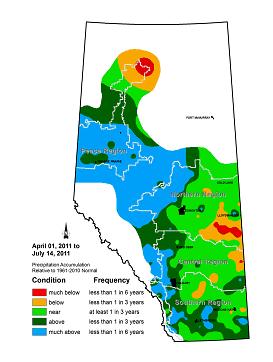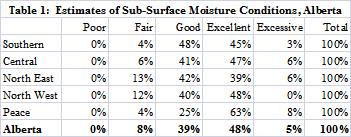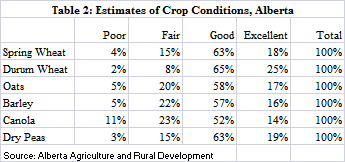| | Virtually all areas of the province received rain during the past two weeks. In the Southern and Central Regions precipitation ranged from 5 to 60 mm. Most of the North East Region received between 25 and 60 mm of rain, while the North West Region received from 64 to over 140 mm. Precipitation in the southern portion of the Peace River Region ranged from 50 to over 120 mm, while the drier northern portion received between 25 and 38 mm. Overall, soil moisture reserves in the province are adequate to excessive. Table 1 below presents estimates of sub-surface moisture conditions for the province, by region. Areas with excessive surface moisture are reported in all regions, with the North East, North West and Peace Regions reporting from 11 to 29 per cent of crop land being excessively wet. Scattered hailstorms were reported in all regions with the exception of the Peace. For the most part, the hail caused minor damage, but localized areas in the Southern and North East Regions did experience severe damage.
.
Provincially, about 83 per cent of spring cereals are in good to excellent condition. Canola crops are reported as 66 per cent in good to excellent condition and 34 per cent in poor to fair condition (see Table 2). Excessive moisture in the northern part of the province is stressing many crops, particularly canola. Crop development in the northern regions remains about seven to 10 days behind normal. Hot dry weather over the next few weeks is needed for crops to take advantage of the moisture and advance rapidly. In the south, heat and sun have advanced crops quickly, with many caught up from earlier delays.
Rain has slowed the progress of first cut haying operations in the North East, North West and Peace Regions, with only four to six per cent complete. The Central Region is about 38 per cent complete, with good yields and good to excellent quality. In the Southern Region, about 78 per cent of first cut irrigated and 54 per cent of first cut dryland haying operations are complete, with above average yields and good to excellent quality.
Pasture growth provincially is rated as one per cent poor, 15 per cent fair, 48 per cent good, and 36 per cent excellent. Spraying for sclerotinia is reported in many areas and grasshoppers are a major problem in the Peace Region. There are also some reports of lygus bugs in canola crops.
 

Our thanks to Alberta Agricultural Fieldmen, staff of AFSC and the Alberta
Ag-Info Centre for their partnership and contribution to the Alberta Crop
Reporting Program.
Regional Assessments:
The 2011 Alberta Crop Report Series continues to provide summaries for the following five regions:
Region One: Southern (Strathmore, Lethbridge, Medicine Hat, Foremost)
- Although hot, sunny weather predominated over the past two weeks, most areas of the region have had some rain, ranging from 5 to 60 mm. A number of areas reported moderate hail damage, while severe damage was reported in the Rosemary/Duchess area. Moisture reserves are generally fair to excellent.
- Crops are advancing quickly and many have caught up from earlier delays. Spring cereals are in the late boot to head emergence stages, while oilseeds and pulses are mostly flowering, with 10 to 12 per cent podding. Overall, spring cereals are rated as three per cent poor, 12 per cent fair, 63 per cent good and 22 per cent excellent. Canola is rated at one per cent poor, 13 per cent fair, 65 per cent good and 21 per cent excellent.
- First cut haying is well underway, with 78 per cent of irrigated and 54 per cent of dryland complete. Yields are very good for both dryland and irrigated hay. Pasture is in good to excellent condition.
Region Two: Central (Rimbey, Airdrie, Coronation, Oyen)
- Most areas of the region received rainfall throughout the last two weeks, ranging from 5 to 60 mm. Areas in the northwest and central parts experienced cool, wet weather and spotty hailstorms which caused some damage. Moisture reserves are mostly good to excellent, with a few low-lying areas being excessive.
- Crop development is about 7 to 10 days behind normal, although warmer temperatures have helped advance crops in the southern and eastern portions of the region. In general, 83 per cent of canola is flowering, while about 16 per cent is still in the rosette stage and one per cent is podding. Most cereal crops are in the late boot stage, with some starting to head. The overall condition of spring cereal, canola and dry peas is rated as good to excellent.
- First cut dryland haying operations have been hampered by rain over the past two weeks, with 38 per cent now complete. Although yields are very good, there is concern that rain has reduced the quality of hay that was in swath. Pasture is rated as good to excellent.
Region Three: North East (Smoky Lake, Vermilion, Camrose, Provost)
- Precipitation during the last two weeks ranged from 25 to 60 mm in most areas of the region, with localized areas reporting heavy amounts of 150 to 250 mm. Throughout the region, heavy rain has left standing water in some fields. Hail in the Lamont and Chipman areas caused extensive crop damage.
- Cereal crop development remains behind normal, with wheat being the most advanced and just starting to head. The majority of cereals are in good to excellent condition. Canola development is varied, with the majority in flower, and is rated at 77 per cent in good to excellent condition. Spraying with fungicide to prevent sclerotina in canola and leaf diseases in cereal crops is becoming common.
- Rain has significantly delayed first cut hay operations, with only four per cent complete. Many cut fields have been rained on, reducing quality. Tame hay and pasture conditions range from fair to excellent.
Region Four: North West (Barrhead, Edmonton, Leduc, Drayton Valley, Athabasca)
- Heavy rain, ranging from 64 to over 140 mm, was reported in most areas of the region, with reports of some localized areas receiving up to 178 mm. A small amount of hail damage has been reported throughout the region.
- Cereal crop development is still behind normal. Spring wheat is most advanced, with one-half head emergence being common. About 70 per cent of canola is in flower, 28 per cent in rosette and two per cent podding. Many crops are stressed from the excessive moisture, with flooded areas reported in some fields. Generally, cereal crops are reported as seven per cent poor, 39 per cent fair, 47 per cent good and seven per cent excellent. Canola is 25 per cent poor, 40 per cent fair, 29 per cent good and 6 per cent excellent.
- First cut haying has been delayed by rain, with only four per cent of operations complete. Many cut fields have been rained on, reducing quality. Tame hay and pasture conditions vary from fair to excellent.
Region Five: Peace River (Fairview, Falher, Grande Prairie, Valleyview)
- Heavy rains in the south and central parts of the region over the past two weeks added another 50 to more than 120 mm of moisture to the heavy precipitation previously received. The northern portion of the region, which has been dry, received 25 to 38 mm of rain during the past week.
- Many crops, especially canola, are being stressed by excess moisture, with lower areas in some fields being flooded out. In general, cereal crop conditions are rated as 12 per cent poor, 23 per cent fair, 44 per cent good and 21 per cent excellent. Canola is reported as 17 per cent poor, 26 per cent fair, 39 per cent good and 18 per cent excellent. Grasshoppers have become a moderate to severe problem in the northern and western parts of the region and some spraying has been done. There are also some reports of lygus bugs on canola.
- The recent rainfall has delayed first cut haying operations, with only six per cent complete. Tame hay and pasture growth is rated as mostly good to excellent.
Alberta Agriculture and Rural Development
Economics and Competitiveness Division
Statistics and Data Development Branch
July 19, 2011 | Marion Harry, Research Assistant
E-mail: marion.harry@gov.ab.ca
Phone: 780-427-9206 |
Note to Users: The contents of this document may not be used or reproduced without properly accrediting Alberta Agriculture and Rural Development, Economics and Competitiveness Division, Statistics and Data Development Branch.
The 2011 Alberta crop reporting series is available on the Internet at: http://www1.agric.gov.ab.ca/$department/deptdocs.nsf/all/sdd4191 |
|